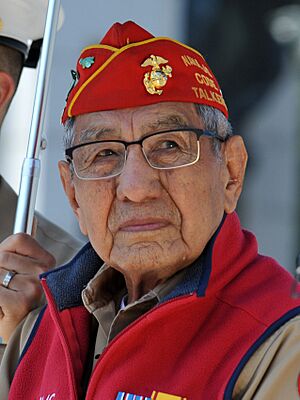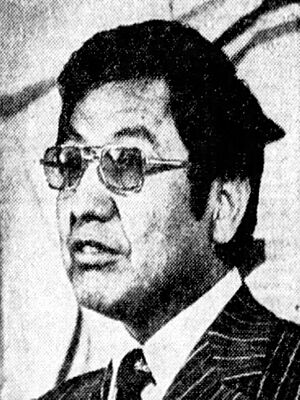Peter MacDonald (Navajo leader) facts for kids
Quick facts for kids
Peter MacDonald Sr.
|
|
|---|---|

MacDonald in 2022
|
|
| Chairman of the Navajo Nation | |
| In office January 10, 1987 – February 1989 |
|
| Vice President | Johnny Thompson |
| Preceded by | Peterson Zah |
| Succeeded by | Leonard Haskie |
| In office January 10, 1971 – January 15, 1983 |
|
| Vice President | Wilson Skeet (1971-1979) Frank E. Paul (1979-1982) |
| Preceded by | Raymond Nakai |
| Succeeded by | Peterson Zah |
| President of the Navajo Code Talker Association | |
| In office February 2012 – August 2022 |
|
| Chairman of the Navajo Code Talkers Museum | |
| Assumed office August 2022 |
|
| Personal details | |
| Born |
Hashkasilt Begay
December 16, 1928 Teec Nos Pos, Arizona, United States |
| Nationality | American Navajo Nation |
| Political party | Republican |
| Residence | Tuba City, Arizona |
| Education | Bacone College, University of Oklahoma (BSEE), University of California, Los Angeles |
| Occupation | Public speaker, Engineer (formerly) |
| Military service | |
| Branch/service | |
| Years of service | 1944–1946 |
| Rank | Corporal |
| Unit | 6th Marine Division |
| Battles/wars | World War II |
Peter MacDonald (born December 16, 1928) is an important Native American leader. He is the only person to serve four terms as Chairman of the Navajo Nation. MacDonald was born in Arizona, U.S. During World War II, he served in the U.S. Marine Corps as a Navajo Code Talker. He was first chosen as Navajo Tribal Chairman in 1970.
Later, in 1989, the Navajo Tribal Council removed MacDonald from his position. This happened because of federal investigations into his actions. MacDonald was sent to federal prison in 1990 after being found guilty of breaking U.S. laws, including charges related to fraud and corruption. He was later forgiven and released.
MacDonald is married to Wanda MacDonald. They have five children and nine grandchildren.
Contents
Early Life and Education
Peter MacDonald's birth name was Hashkasilt Begay, which means "He Who Clasps With Power." He grew up among traditional shepherds and was taught about the ways of a medicine man.
During World War II, he joined the Marine Corps as a code talker. These special soldiers used the Navajo language to send secret messages that enemies could not understand. The war ended shortly after he finished his training. He was then sent to China to guard Japanese officers after the war.
After the war, MacDonald went to the University of Oklahoma. He earned a degree in electrical engineering in 1957. His skills helped him get a job at the Hughes Aircraft Company. There, he worked on important projects like the Polaris missile. In 1963, he returned to the Navajo Nation and began his career in tribal politics.
Political Career and Leadership
Peter MacDonald served as the Navajo Nation Tribal Chairman for four terms. These terms were between 1970 and 1986. As Chairman, MacDonald focused on making the Navajo Nation more self-sufficient. This meant helping the tribe manage its own affairs and businesses. He worked to give the tribe more control over education and over the use of its natural resources.
In 1975, he helped start the Council of Energy Resource Tribes (CERT). This group worked to help tribes manage their energy resources and get fair prices for them. MacDonald is also known for starting many Navajo-owned businesses. These include the Navajo Nation Shopping Centers Enterprise and the Navajo Engineering and Construction Authority. He often spoke out against the Bureau of Indian Affairs and worked to protect the tribe's right to govern itself.
During the 1972 presidential election, some people called MacDonald "the most powerful Indian in the USA." He was part of Richard Nixon's campaign team. However, MacDonald later considered supporting Democratic candidate George McGovern. This was because he felt Nixon was not fully supporting the Navajo side in a land disagreement with the Hopi tribe.
MacDonald's political influence was clear in 1974. He helped elect Democrat Raul Hector Castro as governor of Arizona. This showed his ability to gather strong support from the Navajo people.
A long-standing land dispute between the Navajo and Hopi tribes led to many Navajo families losing their homes. This created tension between MacDonald and Senator Barry Goldwater. In 1996, a law was passed that allowed some families to stay on their lands longer. A rule called "The Bennett Freeze" also affected many Navajo people. This rule limited building and development on certain lands. It was finally removed in 2009 by U.S. President Barack Obama.
Community Service and Organizations
Peter MacDonald also played a role in several important organizations:
- He helped start the American Indian National Bank in Washington, D.C. This was the first bank for Native American tribes across the country.
- He co-founded the National Tribal Chairman Association. This group allowed elected tribal leaders to speak together on behalf of their people.
- He was a co-founder and chairman of the Council of Energy Resources Tribes (CERT). This group worked to improve how Native American energy resources were managed and protected.
- He served on the Board of Regents for Navajo Community College (now Diné College).
- He helped start the Native American Preparatory School (NAPS) in 1986.
Legal Challenges and Pardon
In 1976, U.S. Senator Barry Goldwater asked for a review of the tribe's money. This led to charges against MacDonald. He was accused of filing false travel documents. MacDonald was found not guilty of these charges.
Later, in February 1988, the Navajo Tribal Council decided to put Chairman MacDonald on leave. MacDonald did not want to step down, which led to a difficult situation for several months. The council then chose a temporary chairman. Some of MacDonald's supporters, known as "Peter's Patrol," took over his offices.
In 1989, the Navajo Nation Council officially suspended MacDonald. They suspected he had accepted money from contractors and companies. This led to unrest in Window Rock a few months later.
MacDonald was later found guilty in tribal court of misusing tribal funds. He served some time for this. Then, he was found guilty in federal court of other charges, including those related to the unrest in Window Rock. He also served a federal sentence for charges related to fraud.
In 1990, Peter MacDonald was sent to the Federal Correctional Institution, Fort Worth in Texas. He was later moved to a prison hospital due to health issues.
Sentence Commuted
In 1995, the Navajo Tribal Council forgave MacDonald while he was still in prison. They noted that some accusations against him might not have been true. They also wanted to restore the Navajo idea of hozhonji, or the Beauty Way, which includes forgiveness.
On the day before President Bill Clinton left office in 2001, he granted MacDonald's request for an early release from prison. This decision was made along with many other pardons and commutations.
Since his release from federal prison, Peter MacDonald has continued to be a public figure. He speaks out for more Navajo self-governance and less federal control over certain areas. He often gives speeches at conferences and educational events.
In 2007, he spoke in Tsiizizii about returning to traditional Navajo family values. He believes parents should play a bigger role in their children's education. He said: "I sincerely believe that we will all be better off if we return to the traditional Navajo system in which the family was important and everyone fulfilled their roles and responsibility for preparing our children for life. I have always believed in school and the importance of education. Education is good, it is needed to make a living and to make a difference, but not everyone looked at it this way. Wisdom, knowledge, and strength are the supports necessary to lead a productive life. These supports must work together like the three legs on a stool. The school and the home must work together."
On November 17, 2017, MacDonald and other Navajo Code Talkers were honored at a White House Ceremony by President Donald Trump. MacDonald introduced his fellow Code Talkers and spoke alongside the president. He talked about how effective the Code Talkers' communication was in battles. He also asked for a national museum to preserve their legacy. He ended his speech by talking about America's unity and strength when facing challenges.
In 2022, he spoke in Washington, D.C. at a celebration honoring Navajo Code Talkers at the National World War II Memorial.
Awards and Recognition
Peter MacDonald has received several awards for his work and achievements:
- University of Oklahoma Engineering Hall of Fame
- Distinguished Service Citation, University of Oklahoma
- Arizona Indian of the Year (1970)
- President Kimble Leadership Award (LDS church)
- Distinguished American Award by National Institute for Economic Development
See also




